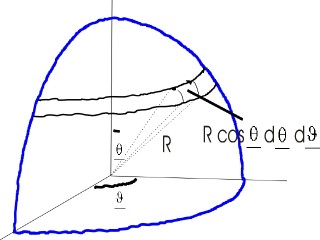|
|
 |
Geometry
The directional aspects of radiative transfer are most
naturally expressed in spherical coordinates, illustrated in Figure 1.
Location is specified by radius r from the origin, zenith angle
q, and azimuthal angle j,
with differential increments dr, rdq,
and  . The amount of radiation
depends on direction, which in three dimensions is specified with solid
angle W, measured in steradians (str). The differential
element dW is the product of the polar
and azimuthal angle differentials. There are 4p
steradians in a sphere: . The amount of radiation
depends on direction, which in three dimensions is specified with solid
angle W, measured in steradians (str). The differential
element dW is the product of the polar
and azimuthal angle differentials. There are 4p
steradians in a sphere:
-

Polar angle is often replaced with its cosine  ,
so that ,
so that  . Polar angle is
measured relative to a beam directed upwards, so q=?
and µ=-1 for a beam pointing straight down and µ>0 for radiation
traveling upwards. . Polar angle is
measured relative to a beam directed upwards, so q=?
and µ=-1 for a beam pointing straight down and µ>0 for radiation
traveling upwards.

-
Geometry in polar coordinates.
Radius r is measured from the origin, zenith angle q
from the vertical, and azimuthal angle j
from the south.
Next
Back
Return to Lesson 2
Return to Satellite Meteorology Main Page
|




